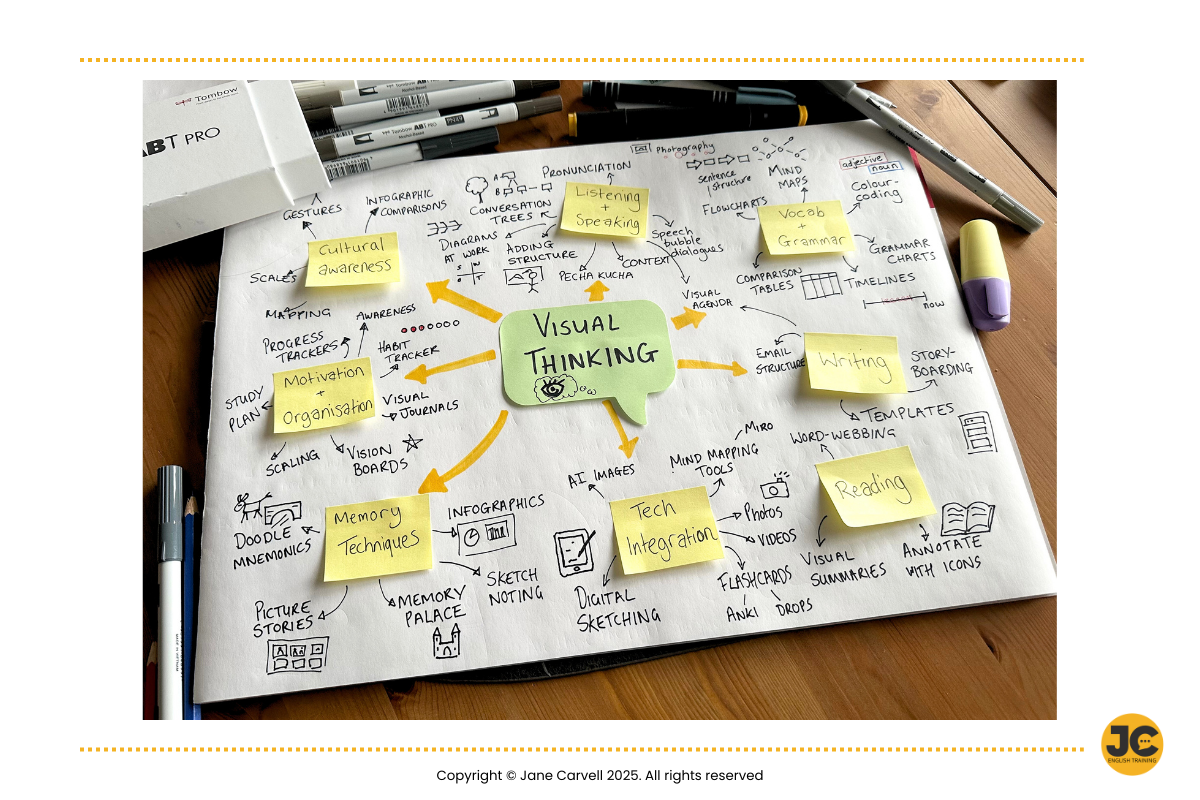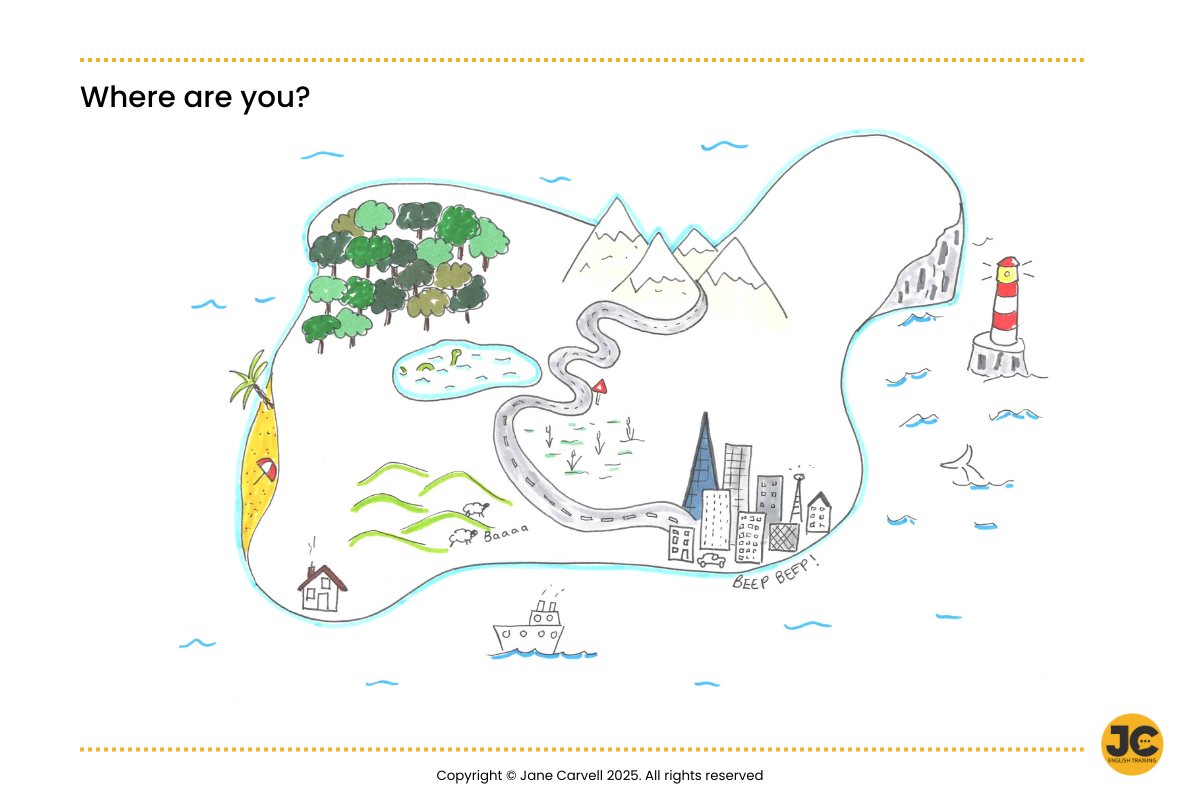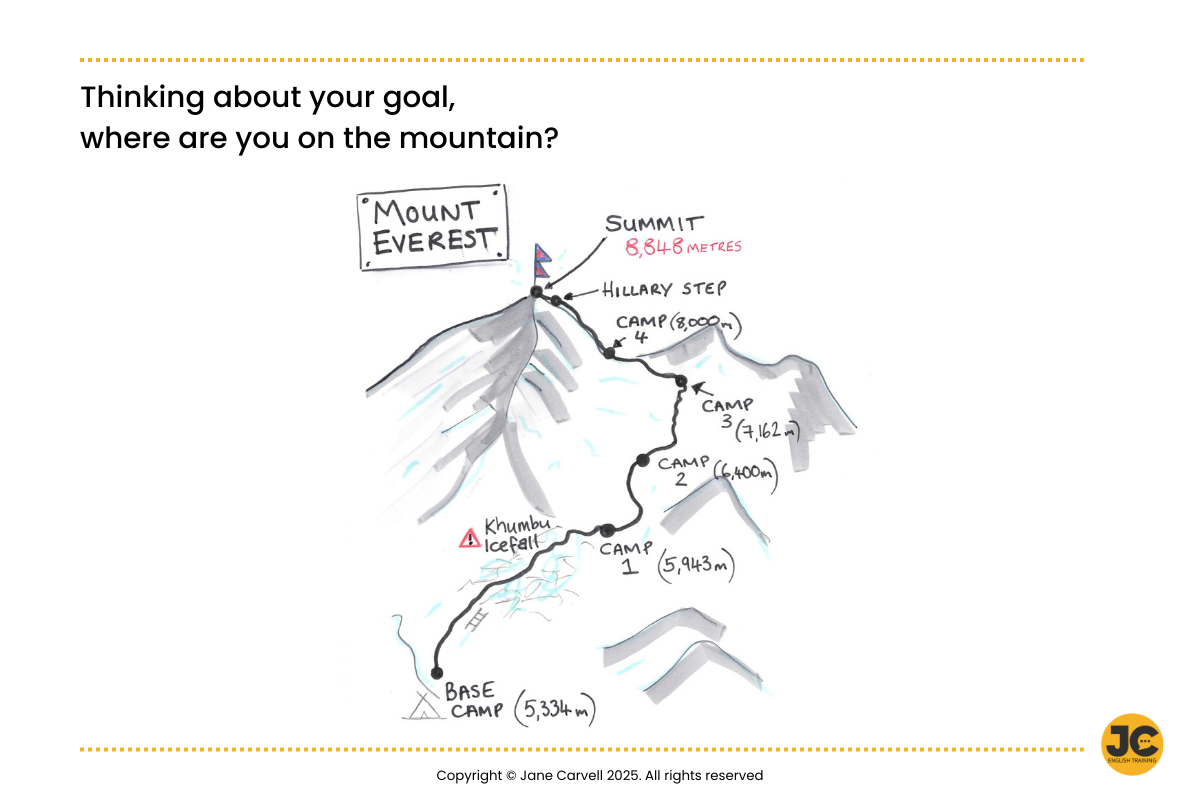4 Simple Ways Language Learners Can Use Visual Thinking
Learning a new language can sometimes feel overwhelming, like stepping into a fog of unknown words, grammar and sounds. How can we get out of the fog? This is where visual thinking comes in – tools that combine images, creativity and structure to help language learners connect ideas, understand concepts and stay motivated.
“Visual thinking helps you understand, explain and connect more effectively.”
Cara Holland, Draw a Better Business (2018)
Visual thinking uses sketches, diagrams, infographics, graphic frameworks, photos and many other visual tools to simplify complex ideas and turn abstract concepts into clearer, more memorable representations. Don’t worry, you don’t need to be an artist to use visual thinking effectively. In fact, you have probably used visual thinking in some way already, maybe you just didn’t realise it.
In this post I’ll share 4 ways I use visual thinking in my English language training and coaching sessions. From introducing yourself with sketches, using visual metaphors, tracking your progress or mapping out new vocabulary these are tools I love to use with my learners, and you can try them yourself too. Let’s take a look…
1. Let me introduce myself…
What it is:
A stress-free way of introducing yourself to a group. Draw a few sketches or doodles which represent you, your job and your interests (e.g. a book for reading or factory to represent your job at a manufacturing company). Then use the drawing to have a conversation. If you don’t feel like speaking at length, people can ask you questions or guess what each sketch shows. Can you guess what the sketches in my example represent?
Why it works:
Visual thinking reduces the pressure of perfect speaking or writing. It’s a fun way to practise, even if the drawings are a bit wonky! (ein bisschen wackelig 😊)
2. Island Visual Metaphor
What it is:
Draw (or use my example) a metaphorical island map to reflect your current feelings, goals and challenges. You can explain each area of the map and where you are now in terms of your language learning or weekly routine. You could come back to or add to the map at different times to track progress.
Why it works:
It helps build emotional awareness and lose inhibitions while incorporating relevant vocabulary by adding labels or describing your map verbally.
Inspired by: A Comprehesive Language Coaching Handbook, p.243 ‘Language Learning Map’ (Gabriella Kovacs, Pavilion Publishing, 2022)
3. Climbing Everest
You might have guessed from my introduction sketch that I love spending time in the mountains – that explains why I often use adventurous analogies in my work with learners. You could use visuals that reflect your own interests and passions too.
What it is: Visualise progress as climbing a mountain, marking different milestones along the way. How far are you up the mountain? How far do you want to go? Who is going to support you? What are you going to do if there are challenges, like ‘bad weather’?
Why it works: It’s a motivational tool that celebrates small wins (even getting to ‘base camp’ is an achievement!) and reminds you of where you are on your language learning journey.
You could use a mountain sketch as a progress tracker by adding your goals to each camp (e.g. ‘prepared and practised my professional introduction’ = camp 3). Colour in each section or draw a flag as goals are reached.
4. Mind mapping for learning & expanding vocabulary
Mind mapping is a really popular way to collect words or brainstorm around a theme. I use mind maps in a wide range of ways. One way to describe a process (such as making a cup of tea, see image) is to visualise the words you need, break it down into parts of speech (verbs, nouns, adjectives etc). Then, when you have the words as building blocks, it’s easier to break down the process into steps and build sentences. In the image (right) you can see I love to use mind maps for my own German language learning. I did this mind map a few years ago when I got a garden at my local Kleingartenverein. I wanted to chat more confidently with my garden neighbours and share gardening tips without searching for words too often.
What it is: Use mind maps to visually organise and connect vocabulary around a theme. Use pictures or sketches for each word to show meaning
Why it works: Psychologically proven to help learners recall words faster and develop ideas. It’s much more engaging and memorable than a boring wordlist. Mind maps definitely work for me, I hope they do for you too!
Visual thinking is a fun and practical way to make learning English more effective. By drawing simple sketches to introduce yourself, creating an island map to explore your feelings and goals, tracking your progress with a Mount Everest chart, or using mind maps to grow your vocabulary, you can turn learning into a creative and memorable experience.
The great thing is, you don’t need to be good at drawing—these ideas are about helping you understand and remember, not about making perfect art. Whether you’re just starting to learn a language or want to try something new, these techniques can make learning stick.
Why not try one of these methods today? I’d love to hear how it works for you. Feel free to share your experience or get in touch to learn more about my passion for visual thinking in language learning!
Follow my blog as I can promise there will be plenty more posts on visual thinking tools.
I recommend these sources if you want to develop your visual thinking skills more:
For ELT teachers (but also useful for learners): Emily Bryson speaks and writes extensively about visual thinking and sketchnoting. Visit her website: Emily Bryson ELT
An online course to practice sketchnoting: Eva-Lotta Lamm explains how to draw simple and engaging visuals in her Domestika course Sketchnoting: Communicate with Visual Notes (It was also great for my German language skills because the course is in German, but there is an English version too)
A book on using visual thinking in business: Draw a Better Business by Cara Holland takes you through the basics of using visual thinking in business. I found many of the tips relevant for language learning too.
Hello,
I’m Jane Carvell, a business English trainer, language coach and visual thinking enthusiast. I help German-speaking professionals improve their English communication skills, so that they can build better connections in an international working world.






